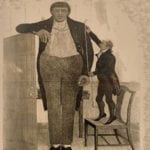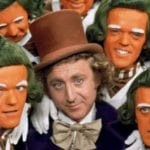 Music
Music  Music
Music  History
History 10 Less Than Jolly Events That Occurred on December 25
 Weird Stuff
Weird Stuff 10 Funny Ways That Researchers Overthink Christmas
 Politics
Politics 10 Political Scandals That Sent Crowds Into the Streets
 Weird Stuff
Weird Stuff Ten Bizarre Facts About The Doge Meme
 Our World
Our World 10 Ways Your Christmas Tree Is More Lit Than You Think
 Movies and TV
Movies and TV The 10 Coolest Stars to Set Sail on The Love Boat
 History
History 10 Things You Didn’t Know About the American National Anthem
 Technology
Technology Top 10 Everyday Tech Buzzwords That Hide a Darker Past
 Humans
Humans 10 Everyday Human Behaviors That Are Actually Survival Instincts
 Music
Music 10 Surprising Origin Stories of Your Favorite Holiday Songs
 History
History 10 Less Than Jolly Events That Occurred on December 25
 Weird Stuff
Weird Stuff 10 Funny Ways That Researchers Overthink Christmas
Who's Behind Listverse?

Jamie Frater
Head Editor
Jamie founded Listverse due to an insatiable desire to share fascinating, obscure, and bizarre facts. He has been a guest speaker on numerous national radio and television stations and is a five time published author.
More About Us Politics
Politics 10 Political Scandals That Sent Crowds Into the Streets
 Weird Stuff
Weird Stuff Ten Bizarre Facts About The Doge Meme
 Our World
Our World 10 Ways Your Christmas Tree Is More Lit Than You Think
 Movies and TV
Movies and TV The 10 Coolest Stars to Set Sail on The Love Boat
 History
History 10 Things You Didn’t Know About the American National Anthem
 Technology
Technology Top 10 Everyday Tech Buzzwords That Hide a Darker Past
 Humans
Humans 10 Everyday Human Behaviors That Are Actually Survival Instincts
Top 10 Blockbuster Movie Scenes Reviewed By Real-Life Spies
It probably won’t come as a surprise that script writers, directors, producers and even actors take some creative liberties recreating real life scenarios in the name of art (or rather, entertainment).
On this list Tony and Jonna Mendez, former CIA agents and Chiefs of Disguise, Jack Barsky, former KGB Agent turned American Intelligence, Peter Earnest, the founding executive director of the International Spy Museum and 35 year CIA veteran and William Colby, former Director of Central Intelligence, review some popular movie scenes that are more art than accurate.
10 Nazi Spies and Their Espionage Plots In America
10 Quick change
In this scene from Mission Impossible III, unlikely hero, Ethan Hawkes, uses the quick change methodology to disguise his identity. And he does it well, seamlessly transitioning into a cassock and posing as a priest.
According to Jonna Mendez, however, disguising an agent as a religious figure, media or peace corps is off limits. These vulnerable vocations need to be protected from the scrutiny they might be subjected to if they were suspected of harboring agents.
Believe it or not, one of the movie quick changes Jonna approves of happens in Teenage Mutant Ninja Turtles when April goes from librarian-type to naughty school girl while moving through a crowd; the bigger the crowd the more forgiving they are and the easier it is to change your appearance with small tweaks and layering.[1]
9 Gadgets
If there’s one thing we all look forward to when a James Bond film is released it’s to see the crazy and clever gadgets Q has dreamed up in his workshop. The clip above shows the “gadget room” in the movie Kingsman and according to Dr Vince Houghton, most of them are either fictional or behind the times.
During his career as an intelligence officer, Jack Barsky mostly made use of everyday ordinary items. He recalls passing messages in film cannisters and finding a passport and money hidden in a rusty oil can.
Pens are a popular spy movie gadget and although, in real life, they aren’t necessarily used as weapons, Jonna Mendez does remember instances where a pen was used to secrete a camera and even an L-pill (lethal pill used by agents who are captured and choose to commit suicide rather than be subjected to torture). And yes, sadly, L-pills are entirely real and have been used in several instances.[2]
8 What not to wear
When you think of the Matrix costumes, most likely you think leather and PVC. Who could forget Neo’s full-length leather jacket or Trinity’s PVC catsuit?
What do our real-life spies think of their outfits, though?
“I’ve never met a KGB officer in a leather jacket,” Jack Barsky, former KGB. “The whole point of being a spy is that you don’t want to look like one.”
To William Colby, former Director of Central Intelligence or America’s top spy, a real spy has to be ”a gray man who has a hard time catching the eye of a waiter in a restaurant.”
And Jonna Mendez agrees. When reviewing a clip from Avengers 1998 in which Uma Thurman sports yet another PVC catsuit, Jonna asks why they are so popular in movies… And then answers her own question with “because women look so good in them. At least Hollywood women do.” Most real agents, men and women, she continues, would not be caught dead in them.[3]
7 Masks
The Mission Impossible franchise is well-known for its mind blowing masks – which, according to our experts, are a result of CGI and clever camera angles rather than latex. Because although real life masks can change a lot about a person’s face including gender and ethnicity, not even the Chief of Disguise at the CIA can guarantee animation. Masks are also additive; this means you can, for example, add bulk to a small nose, but you can’t hide a big nose with a small one.
During his tenure at the CIA, Tony Mendez made masks and disguises to allow CIA officers to slip past the watchful eyes of the KGB, meet foreign agents and collect secrets cached in dead drops without being detected by counterspies. He even helped a black CIA officer meet an Asian diplomat in a city under martial law and Soviet surveillance. He asked a Hollywood makeup artist he knew to send him some masks and transformed the case officer and the envoy into Caucasian gentlemen. They met undeterred by roadblocks and checkpoints.[4]
6 Self-defense
When reviewing this clip from Iron Man 2, Jack Barsky remarks that although he was greatly impressed with the acting, the Black Widow’s self-defense techniques were considerably more aggressive than anything he was ever trained in. Which says a lot considering he used to work for the KGB!
Jack continues by explaining that although agents are trained in self-defense in case they find themselves in a dark alley confronted by an unsavory character who wishes to harm them (which seems likely due to the nature of the job), most agents are not as proficient in hand to hand combat as Hollywood would have you believe. Their purpose, after all, is to fly under the radar and gather intelligence rather than drawing attention to themselves by starting a fist fight.[5]
5 Cultural customs
In this scene from Inglourious Basterds, the British soldier gives himself away by counting incorrectly on his hand. Europeans start with the thumb. Within a split second the German soldier realizes the man is European.
Jonna Mendez remarks that it is incumbent on the spy to learn not only the language but also the customs, mannerisms and procedures of the country/area within which they operate. “And sometimes,” she says, “once you’ve outed yourself there is no way out and you have to live with the consequences.”[6]
4 Crowds
Following on from the example above, blending into the crowd is the safest way for a spy to “disappear”. But even doing little things differently to those around you can help those on the lookout spot you. During this scene from Casino Royale, the man in the crowd is called out for having his hand to his ear, touching his earpiece.
Jonna Mendez’ team at the CIA came up with a no hands/body harness-type system to prevent exactly this. She also made it her life’s work to understand how fashion influences people’s conclusion about those around them in order to help her colleagues and other agents “blend in”.
Uniforms are also often used to help agents blend in, and although the CIA doesn’t have stores of uniforms, they can arrange pretty much anything.[7]
3 Documents
We all know this scene from Bourne Identity or any other spy movie – identity documents stored in a safe place just waiting for the right person to find and use them.
In reality, though, these kinds of documents are far too valuable to leave lying around just “in case” someone needs them. According to our experts, aliases are specifically created for specific agents and are very closely controlled by intelligence agencies. Putting together alternate identities is painstaking and meticulous.
Together with identity documents and passports, agents are also provided with pocket litter—those little pieces of paper, pictures and random stuffs we all collect in our purses or billfolds. They work hand in hand with the all-important cover story, which is also the next entry.[8]
2 Cover story
“Spies are people too,” says Jack Barsky. To help them do their jobs, they need believable back stories. Something they can identify with and talk about spontaneously and believably, either as an individual or as a group.
Argo is the real-life story of how Tony Mendez helped to create the escape plan, the false identities and the brilliant disguises that let six Americans escape revolutionary Tehran, where they had been held hostage, in 1980.
The movie, starring Ben Affleck as Tony Mendez, won the Oscar for Best Picture in 2013 and both Tony and Jonna Mendez were heavily involved in the making of it. The cover story, a Hollywood location scouting team, had to be something that Tony and his team could easily talk about.[9]
1 Sexpionage
The movie Red Sparrow is based upon the book of the same name by Jason Matthews, a former CIA operative, and explores the idea of the seduction methodology which is mostly associated with Germans (males called Romeos) and Russians (females called Swallows).
All of our experts agree that the art of seduction does play a role in espionage today and that it’s not that far-fetched to think the Americans use it too.
“I think sexpionage, that’s reality. I’d be surprised if there are any major intelligence services that aren’t in some way recruiting women to do dirty work,” says Jack Barsky.
But, unlike the one in the movie, it’s highly unlikely the CIA has a school of seduction.
At least, that’s what Jonna Mendez says…[10]

![Top 10 Most Important Nude Scenes In Movie History [Videos] Top 10 Most Important Nude Scenes In Movie History [Videos]](https://listverse.com/wp-content/uploads/2019/09/sharonstone-150x150.jpg)






